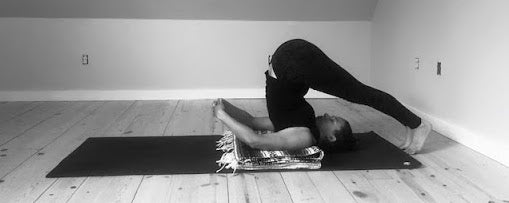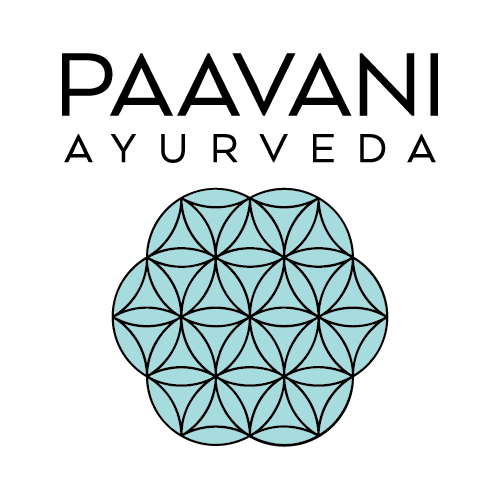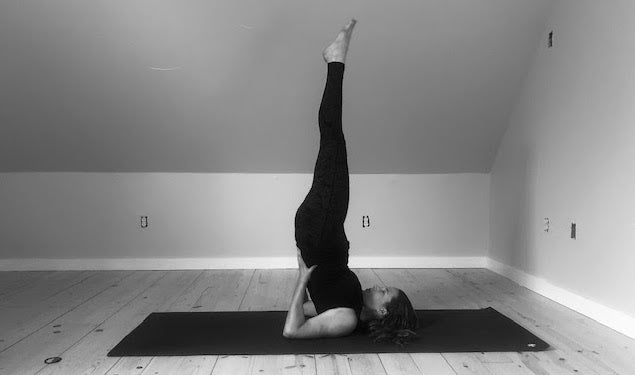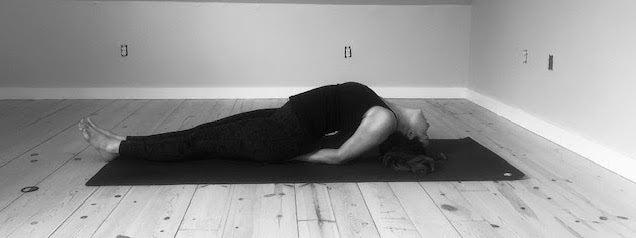
Halasana: An Ayurvedic Guide to Plough Pose

Halasana is a Yoga posture derived from the Sanskrit word ‘hala’ which means plough and ‘asana’ which means ‘pose’. Thus, the literal translation of this posture is Plough Pose. A plough has been used in farming for centuries to help loosen and turn up nutrient rich soil in preparation for planting. Quite literally, halasana brings the body into a position that resembles a plough and like the farming tool, this Yoga posture has the ability to prepare the body for rejuvenation and brings fresh prana to the surface. There are a multitude of benefits to this inversion including:
From the Ayurvedic perspective, Halasana is beneficial for all three doshas:
Vata- Plough Pose is done lying on the back which helps increase the earth element. This fact alone helps to restore stability and groundedness for light and airy vata dosha. Halasana also restores balance to the nervous system which helps to calm fear and anxiety commonly associated with excess vata. The posture’s ability to calm the nervous system can result in reduction of insomnia for vata types as well as improved digestion and elimination of vata type gas or flatulence. When working to balance vata dosha in Halasana, focus on remaining still and stable and hold the posture for an extended period of time with awareness on a long, even and grounding breath.
Pitta- Many inversions are not recommended for pitta dosha because they can bring excess heat into the mind and brain. Also, pitta types tend to overdo it and overexert themselves in general; thus, physically challenging postures like inversions may not be the best choice in their yoga practice. However, Halasana is certainly an exception to this ‘rule’. This inversion is more cooling than others because rather than the head and neck completely off the ground like in Handstand, for instance, in Halasana, the neck and head remain on the ground. This reduces the amount of blood and in turn, the amount of heat that moves into the head. This inversion is also soothing to the nervous system which helps to cool and soothe a heated pitta type body and mind. Due to the soothing nature of this posture, it can also be beneficial to reduce pitta type insomnia. Lastly, this posture gives the digestive organs a gentle massage and helps to expel excess heat from the digestive tract. When working to balance pitta dosha in Plough Pose, focus on the comforting energy this posture cultivates and take slow, smooth breaths in and out. Come out of the posture prior to feeling any strain or heat build in the body.
Kapha- Plough Pose helps to improve circulation and digestion and these are excellent benefits to balance the sometimes cold and sluggish nature of kapha dosha. Since this is an inversion, it offers an opportunity to see things from a fresh perspective which is helpful for when kapha types are feeling stuck in a rut and/or uninspired. Halasana also helps tonify the legs and creates space in the middle and upper back which can help break up mucus and congestion in the lungs. Fresh oxygen comes to the brain in this posture which helps gently stimulate and uplift any heavy kapha like feelings such as melancholy and attachment. Lastly, this posture brings a playful aspect to the practice which can help increase feelings of lightness and buoyancy.
How to Do Halasana:
Traditionally, Halasana is practiced directly after Salamba Sarvangasana (Shoulderstand).
Please note, in order to protect the neck, DO NOT MOVE THE NECK FROM SIDE TO SIDE ONCE YOU COME INTO THE INVERSION.
*If you prefer, to protect the cervical spine (neck), use 2-4 folded blankets underneath the neck for support, as shown below:

- Lie face up on your mat with the elbows beside the body and neck relaxed.
- Bend the knees, press the arms and palms against the floor and lift the legs up.
- Bend the knees and place the hands onto the back.
- Walk the elbows towards one another with the knees bent and then walk the hands up towards the shoulder blades as much as you can. This will help lift your hips.
- You should maintain the cervical curve of your neck; thus, your neck will be slightly off the floor but the back of your head is on the ground.
- Press the backs of your upper arms and shoulder blades into the ground.
- Begin to lift your upper spine and straighten your legs, bringing them in line with your hips.
- Your chin will draw slightly into your chest.
- Continue to move the legs up and over your head.
- If you are able, allow the toes and balls of your feet to connect with the ground and press back through your heels to lengthen and stretch the legs.
- You can keep the hands on the back or bring the arms to the floor.
- Interlace the hands and rather than hyperextend the elbows, keep a bend in the elbows and press the tops of the arms into the mat. (It is fine if your forearms are off the floor).
- Breathe comfortably in Halasana for 8-10 breaths.
- To come out of the pose, release the hands if they are interlaced and bring the forearms and palms of the hands onto the mat.
- If your hands are on your back, slowly bring the arms and palms down onto the mat.
- Using the arms and hands as support, slowly roll down onto your back, vertebrae by vertebrae, until your back and feet connect with the floor.
- Be sure to keep the head and shoulders on the floor as you exit the posture.
- Once completely down, take several breaths in and out.
- Move the head gently side to side.
- Allow your body to rest for a moment, receiving the benefits of the pose.
Precautions:
Contraindications for Halasana:





2 comments
@APRavichandran You are most welcome! Thank you for the request. We will consider Ardha Halasana for our next Ayurvedic Asana blog and let you know when we write that particular post.
PAAVANI Ayurveda
While thanking you for the information given about Halasana , I would request your goodselves to provide inf about Ardha Halasana .
AP.Ravichandran
Leave a comment
This site is protected by hCaptcha and the hCaptcha Privacy Policy and Terms of Service apply.